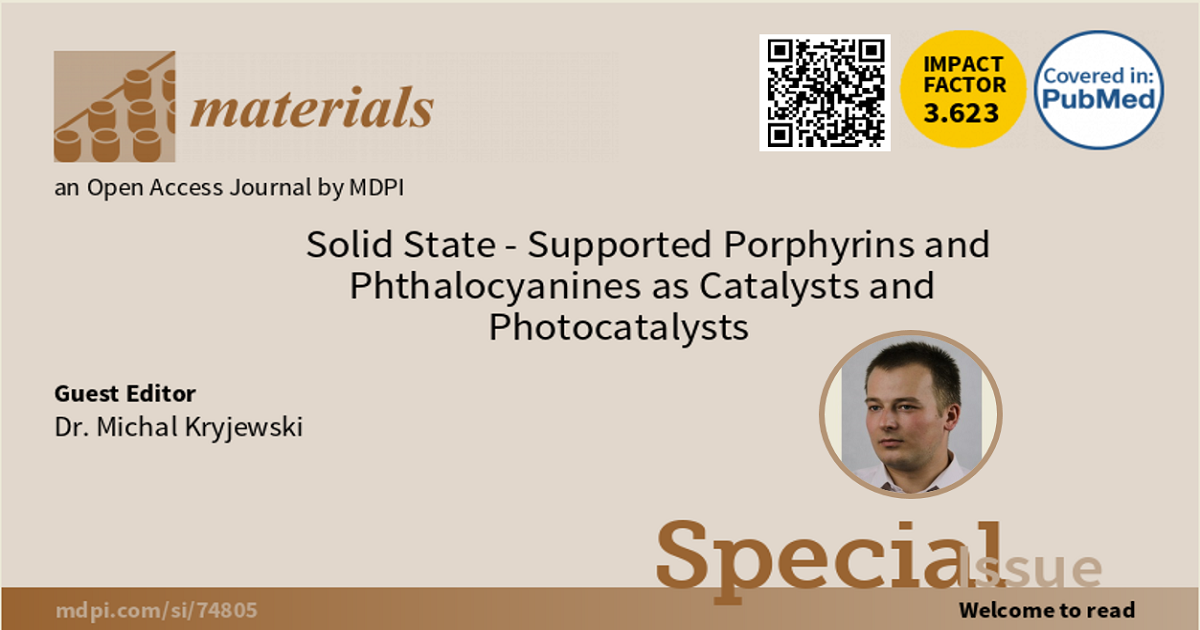Solid State-Supported Porphyrins and Phthalocyanines as Catalysts and Photocatalysts
A special issue of Materials (ISSN 1996-1944). This special issue belongs to the section "Catalytic Materials".
Deadline for manuscript submissions: closed (10 November 2022) | Viewed by 2960

Special Issue Editor
Special Issue Information
Dear Colleagues,
The applications of porphyrins, phthalocyanines, and related macrocycles are intensively studied in many fields. Porphyrinod macrocycles resemble naturally occurring porphyrins and derivatives in both structure and function, and their catalytic and photocatalytic properties are constantly investigated. Porphyrinoids may be used to mimic the activity of cytochrome P450 in selective oxidation of organic molecules, leading to valuable chemicals. As a more robust approach, they could be investigated as a tool for water treatment through the oxidative decomposition of organic pollutants. Upon illumination with light, certain macrocycles may generate reactive oxygen species, including singlet oxygen, which further extends the scope of the catalytic activity. Apart from oxidation reactions, the catalytic activity of porphyrinoid macrocycles also involves the formation of cyclic carbonates from epoxides or coupling reactions of diazo compounds.
The use of macrocycles as homogeneous catalysts has certain disadvantages, such as molecule aggregation caused by π–π stacking interactions or self-oxidation reactions, leading to deactivation of the catalyst. Therefore, there is a strong interest in using porphyrins and phthalocyanines in solid supports, as immobilization facilitates catalyst recovery and reuse, minimizing macrocycle self-oxidation. Various materials have been utilized to date, such as titanium oxide, silica, mesoporous silica, graphene, and carbon nanotubes.
This Special Issue aims to summarize the progress and advances in the development of new catalytic and photocatalytic systems based on solid-state-supported porphyrinoids. You are cordially invited to submit contributions presenting your recent research articles, reviews, and brief communications revealing new trends in the research on porphrinoid macrocycles immobilized on a solid support and their catalytic activity.
Dr. Michal Kryjewski
Guest Editor
Manuscript Submission Information
Manuscripts should be submitted online at www.mdpi.com by registering and logging in to this website. Once you are registered, click here to go to the submission form. Manuscripts can be submitted until the deadline. All submissions that pass pre-check are peer-reviewed. Accepted papers will be published continuously in the journal (as soon as accepted) and will be listed together on the special issue website. Research articles, review articles as well as short communications are invited. For planned papers, a title and short abstract (about 100 words) can be sent to the Editorial Office for announcement on this website.
Submitted manuscripts should not have been published previously, nor be under consideration for publication elsewhere (except conference proceedings papers). All manuscripts are thoroughly refereed through a single-blind peer-review process. A guide for authors and other relevant information for submission of manuscripts is available on the Instructions for Authors page. Materials is an international peer-reviewed open access semimonthly journal published by MDPI.
Please visit the Instructions for Authors page before submitting a manuscript. The Article Processing Charge (APC) for publication in this open access journal is 2600 CHF (Swiss Francs). Submitted papers should be well formatted and use good English. Authors may use MDPI's English editing service prior to publication or during author revisions.
Keywords
- catalysis
- immobilization
- porphyrin
- photocatalysis phthalocyanine
Benefits of Publishing in a Special Issue
- Ease of navigation: Grouping papers by topic helps scholars navigate broad scope journals more efficiently.
- Greater discoverability: Special Issues support the reach and impact of scientific research. Articles in Special Issues are more discoverable and cited more frequently.
- Expansion of research network: Special Issues facilitate connections among authors, fostering scientific collaborations.
- External promotion: Articles in Special Issues are often promoted through the journal's social media, increasing their visibility.
- Reprint: MDPI Books provides the opportunity to republish successful Special Issues in book format, both online and in print.
Further information on MDPI's Special Issue policies can be found here.






